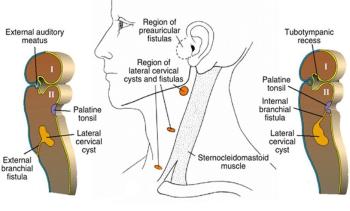
Brankial yarık anomalilerinin kesin tedavisi ameliyat ile tamamını çıkarmaktır. Eksik çıkarılan brankial kistler tekrarlayabilir. Akut enfeksiyon mevcutsa ameliyattan önce antibiyotik tedavisi verilir.
Bazen brankial yarık anomalisinin yolu boğazın arkasına uzanır. Bu durumda kanal kalıntısının tamamen çıkarılması için ağızdan endoskopik görüntüleme gerekebilir. Bu yol eğer bademcik yatağına uzanırsa, aynı zamanda bademcik ameliyatı da gerekebilir.
Boyunda yapılan ameliyatlar damar, sinir gibi pekçok önemli yapıya yakın bir yerde çalışıldığı için her zaman bazı riskler içerir ama deneyimli cerrahlar sayesinde çoğu komplikasyon olmadan gerçekleştirilir.
En büyük risk kistin tekrarlamasıdır. Brankial yarık kalıntısı bütünüyle çıkarIlmazsa tekrarlar. Hastaların büyük çoğunluğunda kist tek bir prosedürde başarıyla çıkarılır ve hiçbir zaman başka bir problem yaşanmaz.
Boynun büyük damarları, yani boyundaki ana atar ve toplar damarlar genellikle brankial yarık anomalisinin duvarı ile yakından ilişkilidir. Bunları kistten ayırmak ve korumak için büyük özen gösterilmelidir aksi takdirde yaralanabilirler.
Ayrıca dili hareket ettiren sinir ile ses tellerinin hareketini sağlayan sinir, yüzün alt kısmını hareket ettiren sinir ve omuzlarımızı kaldırmamızı sağlayan sinir ameliyat sahasının çok yakınından geçer. Bu prosedürde bu sinirlerin yaralanması nadirdir, ancak konumlarından dolayı yaralanma ihtimalleri vardır.
***********************************************************************************************
Cause of Neck Swelling: Branchial Cleft Cyst Treatment
The definitive treatment of branchial cleft anomalies is surgical removal. Incompletely removed branchial cysts may recur. If acute infection is present, antibiotic therapy is given before surgery.
Sometimes the path of the branchial cleft anomaly extends to the back of the throat. In this case, oral endoscopic imaging may be required to completely remove the remnant of the canal. If this path extends to the tonsil bed, tonsil surgery may also be required.
Surgery on the neck always involves some risks as it is performed close to many important structures such as vessels and nerves, but most of them are performed without complications thanks to experienced surgeons.
The biggest risk is the recurrence of the cyst. It recurs if the branchial cleft remnant is not completely removed. In the vast majority of patients, the cyst is successfully removed in a single procedure and no further problems are experienced.
The great vessels of the neck, namely the main arteries and veins of the neck, are usually closely associated with the wall of the branchial cleft anomaly. Great care must be taken to separate and protect them from the cyst or they may be injured.
In addition, the nerve that moves the tongue, the nerve that moves the vocal cords, the nerve that moves the lower part of the face, and the nerve that allows us to lift our shoulders pass very close to the operating area. It is rare for these nerves to be injured in this procedure, but there is a possibility of injury due to their location.